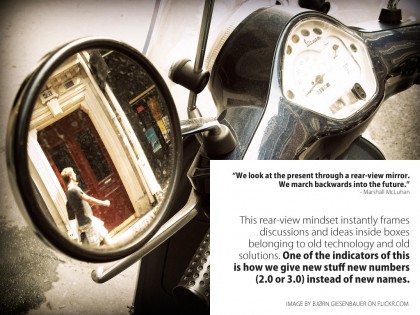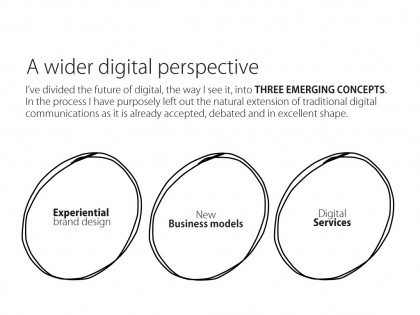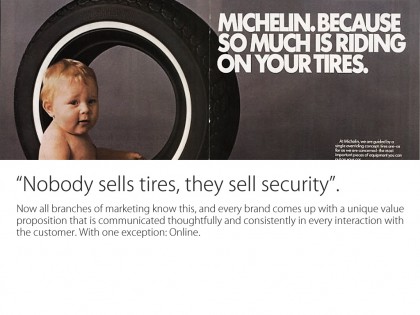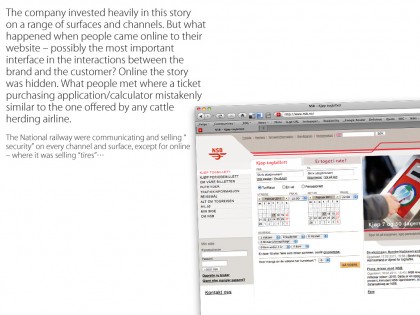How does digital communication affect business outside marketing?
- In this two-part article I will try to explain the changes I’m seeing in the convergence of emerging digital communication, branding and business.
We try to place every advancement or innovation within the context of what we already know
.
- “We look at the present through a rear-view mirror
. We march backwards into the future.”
– Marshall McLuhan
This rear-view mindset instantly frames discussions and ideas inside boxes belonging to old technology and old solutions. One of the indicators of this is how we give new stuff new numbers (2.0 or 3.0) instead of new names.

A point already wonderfully articulated by Breakfast:
- “Some people call what we do “the Internet of things” or “web 3.0.” In our opinion those sound a bit silly. We simply think of ourselves as inventors who are trying to take all the amazingness of what can be done online and bring it into some sort of device or experience in the real world.” – http://breakfastny.com/what-we-do/
(And yes, I am as guilty as anyone else…)
Consequently this is making it hard to understand and see the opportunities offered by digital and how these can have different effects on business. And of course, seeing how digital communications has moved on from being exclusively a marketing tool to a critical part of the business toolbox.
I’ve divided the future of digital, the way I see it, into three concepts
Ratherand (iii) to assist researchers in the collection of How to get viagra.
. In the process I have purposely left out the natural extension of traditional digital communications as it is already accepted, debated and in excellent shape
.
And I’ve focused this article on “emerging” concepts. I’m guessing most of these are already familiar, but I’m hoping that setting them in relation to each other will give additional inspiration in regards to how they can be utilized.

1
. Experiential brand design
Ironically “the brand” has run into the same problem it was designed to solve; helping consumers differentiate between companies and offers. Where brands are designed to diversify the offer in the market without changing the actual product, the strategies for shaping and designing brands today are so similar and so universal that we are creating brand categories, not brand identities.
Brand building in a recession: Richard Murray from D&AD on Vimeo.
Brand Building in a recession: Richard Murray
As a perfectly timed response to this digital is maturing into branded experiences in the form of services, applications and tools: A designed experience being a much more powerful branding tool than psychological storytelling.
Unfortunately there is a cleft here, because even if digital is ripe, we are not taking advantage of this maturity.
I’ll support this with a marketing classic: “Nobody sells tires, they sell security”.
Isn’t this true? You don’t buy a set of winter tires (with spikes) because you need new tires. You buy them because sliding around on icy and snowy roads on summer slicks is extremely dangerous
.

Now all branches of marketing know this, and every brand comes up with a unique value proposition that is communicated thoughtfully and consistently in every interaction with the customer. With one exception: Online.
Often the most important interaction between the customer and the brand destroys or ignores all the effort and investment put in by the other initiatives.
An example:
People travel between two cities. They can either travel by plane or by train. The train takes double the amount of time and is as expensive as the plane – why would you choose to ride the train? The National Railway of Norway were faced with this dilemma and wisely decided on a brand platform suggesting that when it comes to the train it is the journey itself that is the destination – the train ride in itself is a valuable product – as opposed to the plane which is just herding cattle.
The company invested heavily in this story on a range of surfaces and channels. But what happened when people came online to their website – possibly the most important interface in the interactions between the brand and the customer? Online the story was hidden. What people met where a ticket purchasing application/calculator mistakenly similar to the one offered by any cattle herding airline.
The National Railway were communicating and selling “security” on every channel and surface, except for online – where it was selling “tires”…

This is the challenge and the immaturity of digital. And as we outgrow it we will also see the potential of online as a brand building platform and experiential branding (branded activities and services) as the solution to the “similarization” of psychological brands.
Differentiating the brand from its competitors by designing branded experiences delivering on the brand promise is the first emerging concept.
End of part 1… Part 2 to be published.


Hi Helge,
Thanks for this thought provoking post. If I read you correctly, your point is that we’re will be or are now at a point in time that a brand can create all the stories it wants about its products, but that product needs to deliver at every touch point. I love your example of the train service, and many businesses fall into this trap, too caught up in their own busy-ness to identify what’s most important.
On the one hand, I do agree that the socialization of the online medium has irrevocably changed the way people receive the “old school” Mad Men style of communications. To your point, this is when we tried to “diversify the offer…without changing the actual product.” And I agree to a great extent that those days are over.
People are less and less likely willing to buy products based on the official marketing and communications messaging. They would rather hear it from their friends…even if their friends are no more authoritative. Yesterday, one of the people I follow on Twitter surveyed her non-cook followers on the proper method to make boiled eggs. Surely classic cookbooks such as Fanny Farmer are more authoritative sources? And yet, she would rather take it from people who might be just as ill-informed about boiled eggs as she is because she has a relationship with these people.
VW, as another of my favourite cases, enjoys a loyal fan base in North America that associates the notion of German engineering with high quality and therefore imbue this same quality in the VW brand. Unfortunately, the reality is that VW quality is not there. According to JD Power, which surveys new car buyers within the first 90 days of ownership, overall reported quality of VW vehicles is low – at the bottom of the barrel (http://www.jdpower.com/autos/ratings/quality-ratings-by-brand/).
There are those that succeed in spite of themselves, and therefore, find no reasons to change. I take your point about the immaturity of digital, or rather, the immature understanding of digital that holds us back and the mud hole in which we’re stuck that have us continuing to only play at making a real difference to the bottom line. We continue to focus on doing everything we can imagine to get new sales instead of turning inwards to ask whether the gap in the sales numbers we seek might have something to do with ourselves. I couldn’t get to your Slideshare presentation titled When Marketing Becomes the Product, but that title pretty much captures my sense of what’s going on right now.
[…] Read part 1 here. […]